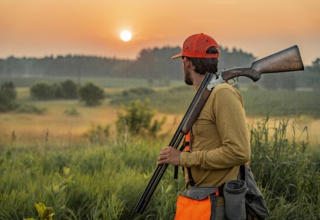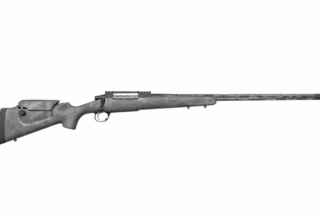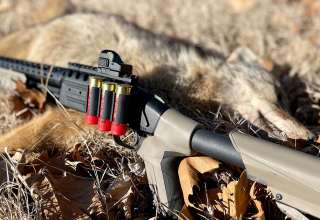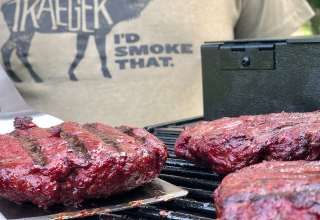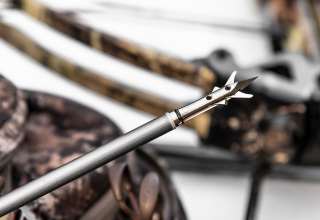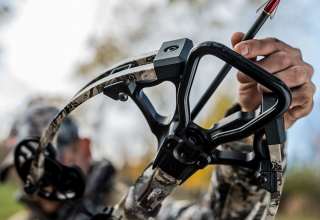In the sport of archery, the bullseye is usually defined to a 1 to 2 inch stationary circle on a block or bag style target. Archers spend countless hours practicing shooting at these targets, so that they are able to hit their desired mark on a consistent basis. When bowhunting turkeys, this task becomes more challenging, because the bullseye is only on a few select locations on a bird that can see hunters movement from over 100 yards away. This keen eyesight is said to have a wide angle view which allows them to have periscope like vision that is noted to be 3 times stronger than the human eye.
Turkeys are a rather small target, this combined with their incredible eyesight is why it is so critical to make a proper shot that will result in a clean and ethical harvest. The first type of shot one may take when hunting with a bow is at the turkey’s head, if it is standing upright or just below the head if strutting. This shot is the same as when hunting with a shotgun, except the hunter does not rely on a wide range of pellets to make the harvest. Instead, the shooter has to rely on the practice they have had at hitting a small dot on a target, thus making connection with the head which is only a few inches wide and approximately 6 inches tall. The second mark is found when a bird is broadside. This shot needs to take place where the butt of the wing connects to the body. The broadhead will likely fracture both wings, while at the same time pierce the heart and/or lungs while the arrow remains lodged into the bird. This prevents the turkey from flying as well as from passing completely through the body. The last shot placement is when the bird is facing away either while walking, or while in full strut. When the gobblers fan is out, aiming directly below the middle of the fan is a great placement for a deadly shot. This scenario allows the hunter to draw his or her bow when the gobbler is facing away with his fan out, blocking all movement.
The key to bowhunting turkeys is getting them in close. By doing the above noted, shot placements become easier. However, one must still get them close enough to make a shot. Below are 3 ways to make it easy to get a gobbler within close bow range.
Blind Placement
 Using a ground blind while bowhunting turkeys has become the desired method for many hunters. Using a blind such as the new Mantis 3 Hub Ground Blind from NAP is crucial. This massive 48 square foot of floor space blind is perfect for the archer. Having lots of room to allow the hunter to draw his or her bow without hitting the sides or the top of the blind.
Using a ground blind while bowhunting turkeys has become the desired method for many hunters. Using a blind such as the new Mantis 3 Hub Ground Blind from NAP is crucial. This massive 48 square foot of floor space blind is perfect for the archer. Having lots of room to allow the hunter to draw his or her bow without hitting the sides or the top of the blind.
Even though ample room is important, where the blind is located is the make or break factor of any hunt. The ideal location is to set the blind in an open area such as a field. The blind needs to have the main shooting windows facing where the hunter can see turkeys coming from a distance. This allows for plenty of time to draw the bow without turkeys catching movement. Next, the blind needs to have a solid background behind it, such as standing timber or brush. If the hunter desires the blind to be in the middle of a field, wearing the proper camouflage is a must, one must make sure that one window is closed so that the human form isn’t silhouetted, and be sure to wear black clothing or a camouflage designed for hunting ground blinds such as Mossy Oak Eclipse which features the Break Up Country pattern overlayed in black, this combination erases the human outline while inside the blind.
Decoy Placement
Once ground blinds are in place, it is the job of the hunter to bring turkeys to it. This is where decoys and calling become important. In my own personal experience, I prefer using at least 3 decoys. Usually an upright hen, a feeding hen, and a jake or gobbler. I like to make it look like there is something going on. Using multiple decoys gives turkeys something to focus their attention on when coming in. When placing the decoys I will place a jake or gobbler facing away. This is so that when a gobbler is approaching he is facing toward me, allowing for more shot opportunities. I will place the upright hen close to the jake or gobbler decoy to represent breeding rituals. The feeding hen is then placed a few yards to the side to resemble realism and to add more for approaching turkeys to see.
The difference when hunting with a shotgun compared to when bowhunting is how far away the decoys are. When setting up decoys specifically for bowhunting, I will place them less than 10 yards from blind, making it easier to hit the desired mark. A good decoy setup creates attention, while at the same time keeping attention away from the hunter.
Proper Broadhead Choices
A quality broadhead, specifically designed for turkey hunting is like a closing pitcher in a baseball game. Everything has been done right leading up to this moment. All that has to be done is to finish it off for the win. This can be made easy with the proper broadhead.
 Compound Bow – If aiming for the body, using a broadhead such as NAP’s Spitfire Gobbler Getter is a great choice because of the unique point design that ensures penetration into the bird while minimizing pass-throughs. With a cutting diameter of 1 ½” , they ensure that the bird will fall in his tracks. If aiming for the head, using a broadhead with a wider cut such as the Spitfire XXX which features a 2” cut is ideal. This particular broadhead has extremely sharp blades that create an extremely deadly result for turkey hunting.
Compound Bow – If aiming for the body, using a broadhead such as NAP’s Spitfire Gobbler Getter is a great choice because of the unique point design that ensures penetration into the bird while minimizing pass-throughs. With a cutting diameter of 1 ½” , they ensure that the bird will fall in his tracks. If aiming for the head, using a broadhead with a wider cut such as the Spitfire XXX which features a 2” cut is ideal. This particular broadhead has extremely sharp blades that create an extremely deadly result for turkey hunting.
Crossbow – NAP also produces some of the toughest crossbow broadheads available. Such as the Killzone Swingfire which is a great body shot broadhead. This is a 100 grain that has pinpoint accuracy of up to 450 fps, it is the first-ever broadhead that independently shifts four different and opposing cutting surfaces, this allows for less resistance and better penetration. For headshots, there is the NAP FOC For Turkey broadhead which is a hard hitting 170 grain broadhead that has 2 blades with an incredible 3” cut when opened. This allows for hitting a smaller target much easier with devastating results.
No matter how experienced the hunter may be, harvesting a turkey with a bow is an accomplishment. Many who have been successful will say that it is an adrenaline filled thrill that keeps them obsessed year after year. Even though it is challenging, by taking advantage of a few of the above mentioned tips and tricks, the task of carrying a turkey over your shoulder will become a yearly routine.


